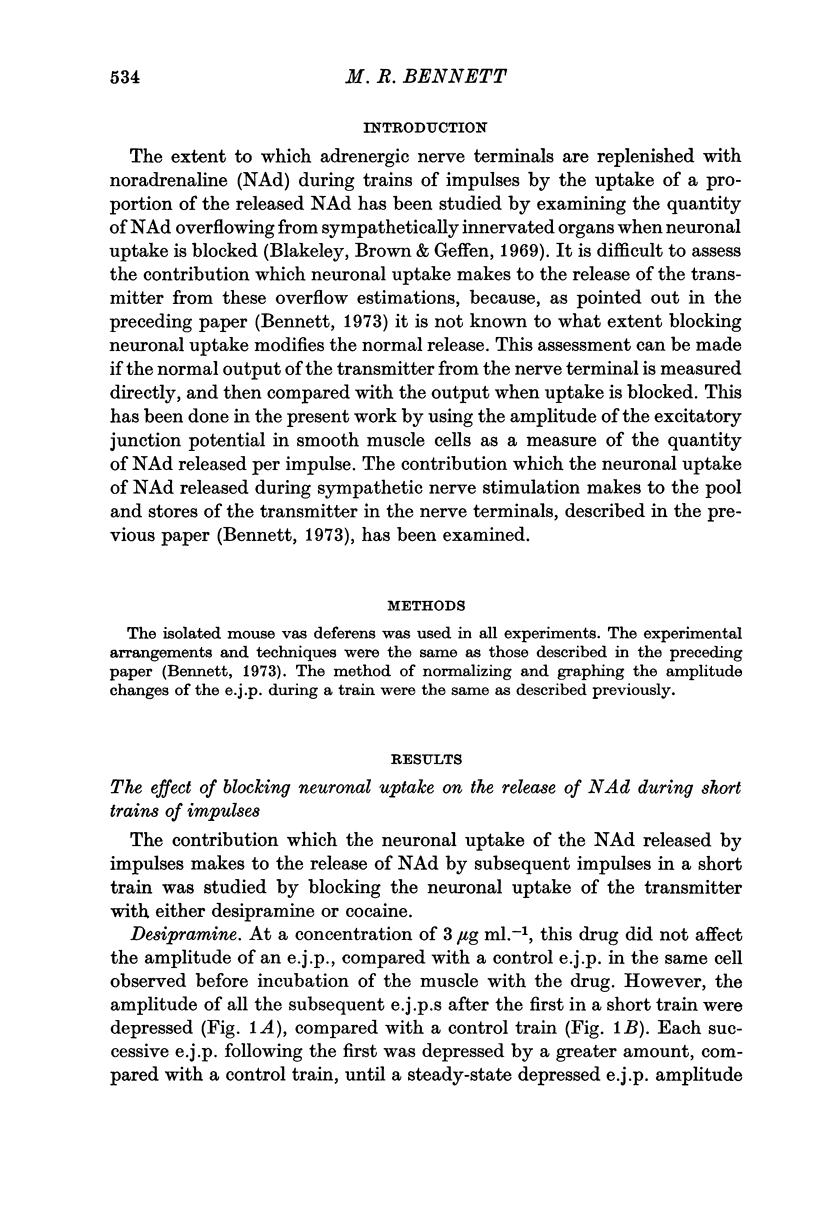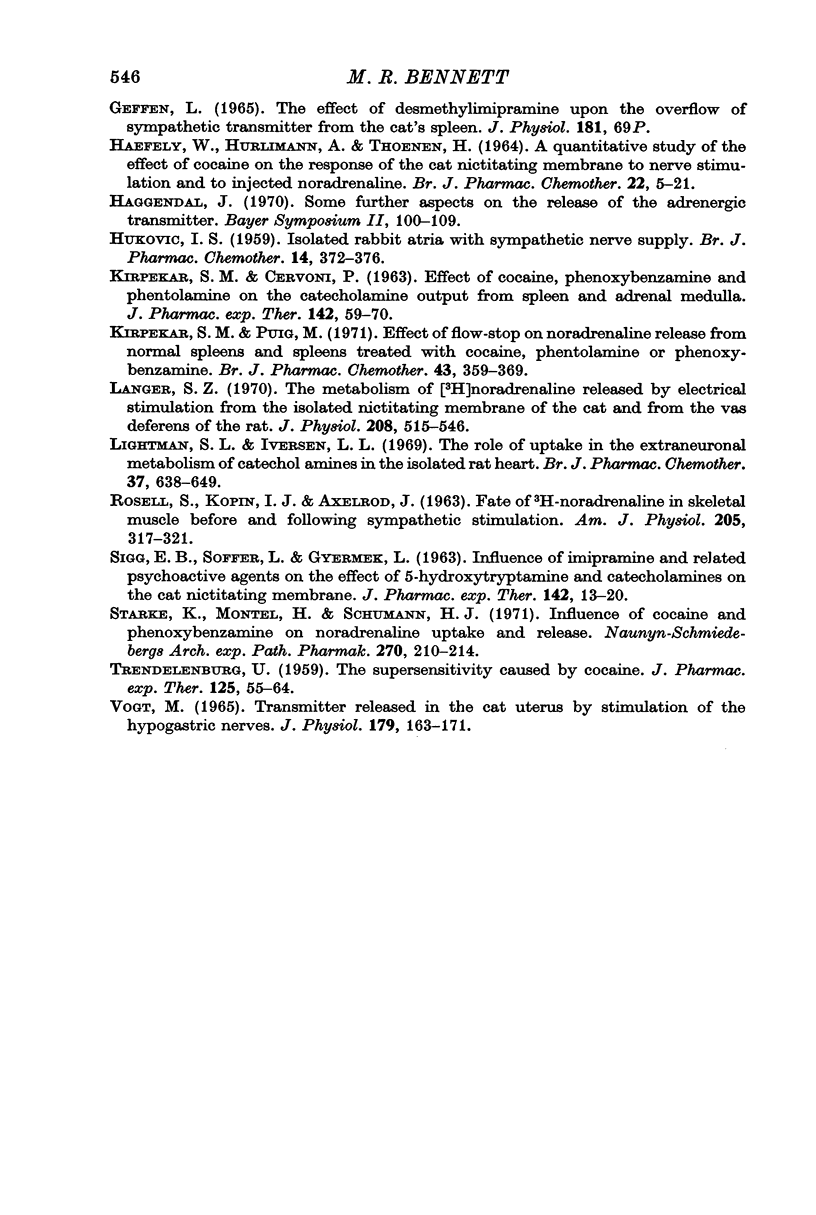Abstract
1. An electrophysiological analysis has been made of the uptake of NAd in the sympathetic nerve terminals of the isolated vas deferens of the mouse. The amplitude of the excitatory junction potentials (e.j.p.s) recorded intracellularly in smooth muscle cells was taken as a measure of the NAd output per impulse from the terminals of sympathetic axons.
2. Neuronal uptake blockers (desipramine and cocaine) greatly depressed the amplitude of all e.j.p.s after the first in a short train (< 100) at high frequencies (≥ 1 Hz).
3. Blocking neuronal uptake did not affect the time course of decline in amplitude of the e.j.p. during long trains of stimulation over several minutes, apart from the immediate depression in the e.j.p. following the first few impulses.
4. The time course of decline of the e.j.p. amplitude during continual stimulation, when both neuronal uptake and synthesis was blocked, was similar to that when only synthesis was blocked, apart from the immediate depression following the first few impulses.
5. Phenoxybenzamine reversed the normal depression in e.j.p. amplitude observed at high frequencies (≥ 1 Hz) to facilitation. This facilitation lasted for several minutes of high frequency stimulation.
6. A model has been proposed of the sympathetic nerve terminal, in which NAd is released by each nerve impulse in a train from a small pool in the nerve terminal, which is principally replenished by uptake of the NAd released by the immediately preceding impulses in the train. The pool is replenished to a less extent by transmitter located in two stores in the terminal which are in turn replenished by transmitter synthesis.
Full text
PDF













Selected References
These references are in PubMed. This may not be the complete list of references from this article.
- BLAKELEY A. G., BROWN G. L., FERRY C. B. Pharmacological experiments on the release of the sympathetic transmitter. J Physiol. 1963 Jul;167:505–514. doi: 10.1113/jphysiol.1963.sp007165. [DOI] [PMC free article] [PubMed] [Google Scholar]
- Bennett M. R. An electrophysiological analysis of the storage and release of noradrenaline at sympathetic nerve terminals. J Physiol. 1973 Mar;229(2):515–531. doi: 10.1113/jphysiol.1973.sp010151. [DOI] [PMC free article] [PubMed] [Google Scholar]
- Blakeley A. G., Brown L., Geffen L. B. Uptake and re-use of sympathetic transmitter in the cat's spleen. Proc R Soc Lond B Biol Sci. 1969 Oct 7;174(1034):51–68. doi: 10.1098/rspb.1969.0080. [DOI] [PubMed] [Google Scholar]
- Boullin D. J., Costa E., Brodie B. B. Evidence that blockade of adrenergic receptors causes overflow of norepinephrine in cats colon after nerve stimulation. J Pharmacol Exp Ther. 1967 Jul;157(1):125–134. [PubMed] [Google Scholar]
- Farnebo L. O., Hamberger B. Effects of desipramine, phentolamine and phenoxybenzamine on the release of noradrenaline from isolated tissues. J Pharm Pharmacol. 1970 Nov;22(11):855–857. doi: 10.1111/j.2042-7158.1970.tb08455.x. [DOI] [PubMed] [Google Scholar]
- Farnebo L. O., Malamfors T. 3 H-noradrenaline release and mechanical response in the field stimulated mouse vas deferens. Acta Physiol Scand Suppl. 1971;371:1–18. doi: 10.1111/j.1748-1716.1971.tb05210.x. [DOI] [PubMed] [Google Scholar]
- HAEFELY W., HUERLIMANN A., THOENEN H. A QUANTITATIVE STUDY OF THE EFFECT OF COCAINE ON THE RESPONSE OF THE CAT NICTITATING MEMBRANE TO NERVE STIMULATION AND TO INJECTED NORADRENALINE. Br J Pharmacol Chemother. 1964 Feb;22:5–21. doi: 10.1111/j.1476-5381.1964.tb01539.x. [DOI] [PMC free article] [PubMed] [Google Scholar]
- HUKOVIC S. Isolated rabbit atria with sympathetic nerve supply. Br J Pharmacol Chemother. 1959 Sep;14:372–376. doi: 10.1111/j.1476-5381.1959.tb00260.x. [DOI] [PMC free article] [PubMed] [Google Scholar]
- KIRPEKAR S. M., CERVONI P. EFFECT OF COCAINE, PHENOXYBENZAMINE AND PHENTOLAMINE ON THE CATECHOLAMINE OUTPUT FROM SPLEEN AND ADRENAL MEDULLA. J Pharmacol Exp Ther. 1963 Oct;142:59–70. [PubMed] [Google Scholar]
- Langer S. Z. The metabolism of (3H)noradrenaline released by electrical stimulation from the isolated nictitating membrane of the cat and from the vas deferens of the rat. J Physiol. 1970 Jul;208(3):515–546. doi: 10.1113/jphysiol.1970.sp009135. [DOI] [PMC free article] [PubMed] [Google Scholar]
- Lightman S. L., Iversen L. L. The role of uptake2 in the extraneuronal metabolism of catecholamines in the isolated rat heart. Br J Pharmacol. 1969 Nov;37(3):638–649. doi: 10.1111/j.1476-5381.1969.tb08502.x. [DOI] [PMC free article] [PubMed] [Google Scholar]
- ROSELL S., KOPIN I. J., AXELROD J. FATE OF H3-NORADRENALINE IN SKELETAL MUSCLE BEFORE AND FOLLOWING SYMPATHETIC STIMULATION. Am J Physiol. 1963 Aug;205:317–321. doi: 10.1152/ajplegacy.1963.205.2.317. [DOI] [PubMed] [Google Scholar]
- SIGG E. B., SOFFER L., GYERMEK L. INFLUENCE OF IMIPRAMINE AND RELATED PSYCHOACTIVE AGENTS ON THE EFFECT OF 5-HYDROXYTRYPTAMINE AND CATECHOLAMINES ON THE CAT NICTITATING MEMBRANE. J Pharmacol Exp Ther. 1963 Oct;142:13–20. [PubMed] [Google Scholar]
- Starke K., Montel H., Schümann H. J. Influence of cocaine and phenoxybenzamine on noradrenaline uptake and release. Naunyn Schmiedebergs Arch Pharmakol. 1971;270(2):210–214. doi: 10.1007/BF00997091. [DOI] [PubMed] [Google Scholar]
- TRENDELENBURG U. The supersensitivity caused by cocaine. J Pharmacol Exp Ther. 1959 Jan;125(1):55–65. [PubMed] [Google Scholar]
- Vogt M. Transmitter released in the cat uterus by stimulation of the hypogastric nerves. J Physiol. 1965 Jul;179(1):163–171. doi: 10.1113/jphysiol.1965.sp007655. [DOI] [PMC free article] [PubMed] [Google Scholar]


